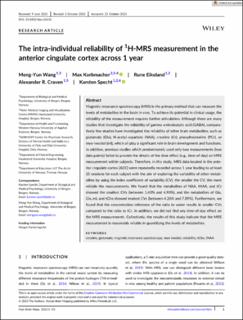The intra-individual reliability of <sup>1</sup>H-MRS measurement in the anterior cingulate cortex across 1 year
Peer reviewed, Journal article
Published version
Permanent lenke
https://hdl.handle.net/11250/3122589Utgivelsesdato
2023Metadata
Vis full innførselSamlinger
- Import fra CRIStin [3604]
- Institutt for helse og funksjon [584]
Sammendrag
Magnetic resonance spectroscopy (MRS) is the primary method that can measure the levels of metabolites in the brain in vivo. To achieve its potential in clinical usage, the reliability of the measurement requires further articulation. Although there are many studies that investigate the reliability of gamma-aminobutyric acid (GABA), comparatively few studies have investigated the reliability of other brain metabolites, such as glutamate (Glu), N-acetyl-aspartate (NAA), creatine (Cr), phosphocreatine (PCr), or myo-inositol (mI), which all play a significant role in brain development and functions. In addition, previous studies which predominately used only two measurements (two data points) failed to provide the details of the time effect (e.g., time-of-day) on MRS measurement within subjects. Therefore, in this study, MRS data located in the anterior cingulate cortex (ACC) were repeatedly recorded across 1 year leading to at least 25 sessions for each subject with the aim of exploring the variability of other metabolites by using the index coefficient of variability (CV); the smaller the CV, the more reliable the measurements. We found that the metabolites of NAA, tNAA, and tCr showed the smallest CVs (between 1.43% and 4.90%), and the metabolites of Glu, Glx, mI, and tCho showed modest CVs (between 4.26% and 7.89%). Furthermore, we found that the concentration reference of the ratio to water results in smaller CVs compared to the ratio to tCr. In addition, we did not find any time-of-day effect on the MRS measurements. Collectively, the results of this study indicate that the MRS measurement is reasonably reliable in quantifying the levels of metabolites.

